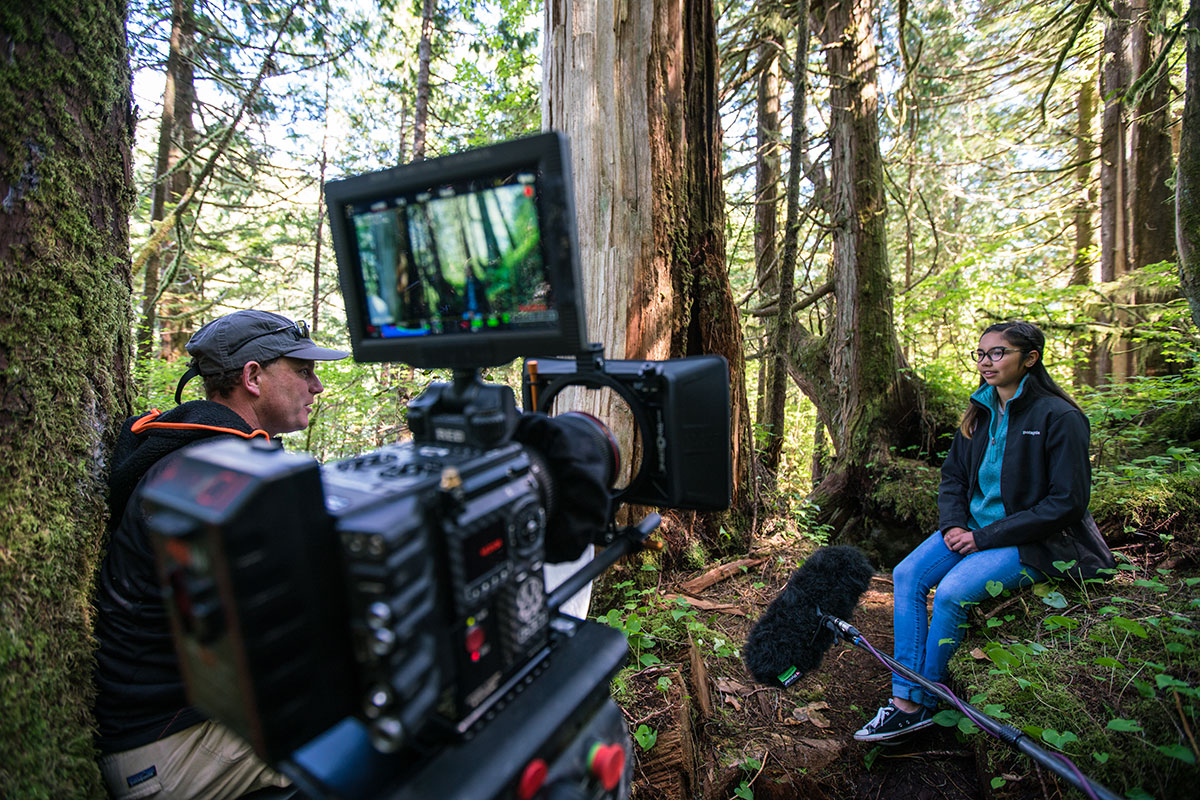“We are a visual species, and as a conservationist I have always believed that visual storytelling is one of the best ways to inspire people to protect a place.” – Ian McAllister
Pacific Wild has brought worldwide attention to the diversity, beauty and challenges facing the Great Bear Rainforest through multiple platforms – visual media has been a cornerstone of what we do since our founding more than 10 years ago. Our Executive Director, Ian McAllister, has carried the idea of the “Great Bear Rainforest” film around with him for nearly twenty years. After a fateful meeting with Seaspan’s Kyle Washington in 2016, the project was finally given the go-ahead. Ian took time off from his role with Pacific Wild to direct and shoot the film with Great Bear Productions, based in Vancouver. In March 2016, the first shoot of “The Great Bear Rainforest” for IMAX began. The IMAX film’s high profile will catapult our existing conservation efforts to an even greater level by being shown in theatres, science centers and museums around the world for up to 25 years.
Our philosophy is that the best way to create empathy for a cause is to put the story right in front of people’s eyes and let it do the talking. Even in the 21st century, there is truly no format that could attempt to do justice to a place like the Great Bear Rainforest like a giant screen film with twelve-channel sound. The legacy of the IMAX format is much longer than a regular feature-length film, sitting for months, even years, in some theatres. We want to show as many people as we can the beauty, diversity, and fragility of this place, through the eyes and voices of the peoples who have lived here for at least 14,000 years. The Great Bear Rainforest film is the story of this place told, as it should be, by its First Peoples.

“We have a belief, in all of our work, that what we have here is not ours. It belongs to future generations. And my Elders have always stated that if you take care of the land, the land will take care of you.” – Doug Neasloss, Kitasoo/Xai’Xais Chief Councillor.
The IMAX format is advantageous not just for its scale, but also for its audience. Approximately 30% of the IMAX viewing audience are students, with teachers integrating IMAX field trips into various parts of the year’s curriculum. “The Great Bear Rainforest” was created with that in mind. The film’s three main human characters are youth representing three First Nations, and each tells a different story about their people’s stewardship of their land and water. Highlighting the various connections between the ocean and the rainforest, the film asks the audience to consider our role as a species for the future of our planet. Our team is working with various partners to build a selection of modern and accessible tools that educators can use to teach their students about the Great Bear Rainforest, its history, ecology, and the efforts being made by First Nations and others to protect it.
“This is so different from most films that have ever been done for IMAX, which are for the most part quite prescribed because of the technology and the expense. This is really one of the first films made for the giant screen where a crew just went out and filmed the wild- ness of a vast coastline. We were really fortunate to have the ability to do that.” – Ian McAllister
We are thankful for the incredible commitment and skill of the communities, filmmakers, producers, sound engineers, deckhands, pilots, and supporters who made this project a reality. It took no small effort, but we hope that it will bring viewers to a new understanding of this incredible place and the relationships between humans, wildlife, and environment, that have made it what it is today.
Starting February 15th, The Great Bear Rainforest will be released to a giant screen theatre near you. Come. Enter. Enjoy. Learn and delight. Be awed, and see for yourself why this untamed outpost—fragile, wild, unbroken—is worth preserving.
To find out where The Great Bear Rainforest is opening near you, and to learn more, go to www.GreatBearRainforestFilm.com
making of the imax
FREQUENTLY ASKED QUESTIONS
Ian McAllister’s IMAX team started filming “The Great Bear Rainforest” in March, 2016. The last shoot that contributed footage to the film was in April, 2018. The team spent approximately 400 days in the field. The majority of the crew were based on a sailboat for the duration of filming.
Around 100 people contributed to the film from pre-production to post production, and it was supported by countless more. In the field, the crew generally ranged in size from 2-20 people.
The IMAX film is a Great Bear Productions project. Pacific Wild was not involved in the making of the film, but is able to use the film to promote its not-for-profit campaign work.
The main title theme was composed by Hans Zimmer and Anže Rozman, of Bleeding Fingers Music. The rest of the score was composed by Anže Rozman with Bleeding Fingers Music.
The IMAX team worked with three coastal First Nations to make “The Great Bear Rainforest” a reality: The Heiltsuk Nation, the Kitasoo/Xai’Xais Nation, and the Gitga’at Nation.
The film is only 42 minutes long, but it packs a whole lot of our favourite B.C. wildlife into those minutes.
The Great Bear Rainforest will be released to the public at designated IMAX theatres starting February 15th. We will be posting all presenting theatres on the film website: www.greatbearrainforestfilm.com, under “Theatres”. Don’t see your home theatre? Keep checking back, as this list is constantly being updated.
At the moment the film is only being released in IMAX theatres. There may, however, be other opportunities to see it on different platforms in the future.
Yes, there are plans for international distribution. Keep up to date on www.greatbearrainforestfilm.com and on our social media channels!
We will be releasing multiple tools over the coming months, including a GBR educator guide by Orca Books, a Google Expedition, and a series of GBR interactive materials in partnership with Ocean School. If you want to know more, feel free to get in touch at info@pacificwild.org.
Yes – One of the advantages offered by new digital technology meant the cameras and rigs were a lot quieter, and more flexible, allowing the IMAX team to capture wildlife in the Great Bear Rainforest with minimal disturbance.
Almost every sound that you hear in the film was recorded in the field by our experienced and talented sound engineer, Tim Archer.
Our team is and always will be respectful of wild animals and our distances. There were instances during filming where animals approached close to our cameras and sometimes our crew, but never in a threatening manner.

